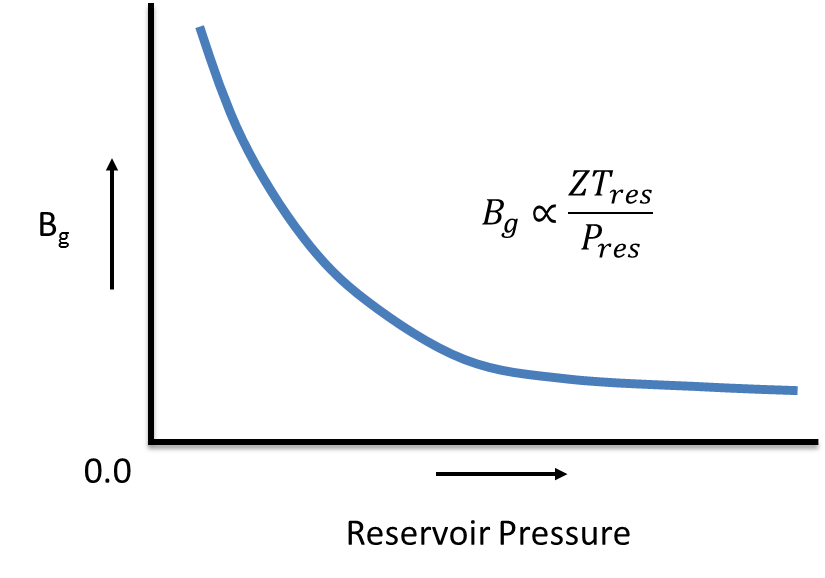Previously we discussed the two phase oil formation volume factor. It accounted for both free gas and oil in the reservoir and had units of ![]() . In order to relate the liberated gas volumes to reservoir barrels, a gas formation volume factor (
. In order to relate the liberated gas volumes to reservoir barrels, a gas formation volume factor (![]() ) was developed. An illustration of how gas formation volume factor is defined is shown below:
) was developed. An illustration of how gas formation volume factor is defined is shown below:

From the figure above, it should be clear that the gas formation volume factor (![]() ) is the total free gas phase volume at reservoir conditions divided by the gas volume of the same sample at standard conditions (
) is the total free gas phase volume at reservoir conditions divided by the gas volume of the same sample at standard conditions (![]() ). Note: it does not include the solution gas volume. The gas formation volume factor has units of
). Note: it does not include the solution gas volume. The gas formation volume factor has units of ![]() . Fortunately in most cases, the phase behavior of gases can be explained by equations and correlations, so we can easily calculate the gas formation volume factor with a simple formula rather than performing a lab test on a gas sample. The expression is shown below:
. Fortunately in most cases, the phase behavior of gases can be explained by equations and correlations, so we can easily calculate the gas formation volume factor with a simple formula rather than performing a lab test on a gas sample. The expression is shown below:
(1) 
Where ![]() is the Z factor,
is the Z factor, ![]() is reservoir temperature, and
is reservoir temperature, and ![]() is reservoir pressure. For gas reservoirs and pipeline calculations, it may be more convenient to express Equation 1 in units of cubic ft/scf. In these cases Equation 1 can be modified to the following:
is reservoir pressure. For gas reservoirs and pipeline calculations, it may be more convenient to express Equation 1 in units of cubic ft/scf. In these cases Equation 1 can be modified to the following:
(2) 
The typical shape of the gas formation volume factor as a function of pressure is shown below:

The figure above shows that the formation volume factor is inversely proportional to pressure. This makes sense because as reservoir pressure declines, the gas will expand to occupy more volume in the reservoir. As we can see ![]() increases as reservoir pressure decreases.
increases as reservoir pressure decreases.
Before you take off it is important to understand that the gas formation volume factor only applies if free gas exists in the reservoir. Therefore if there is no free gas, ![]() is undefined and neglected from material balance calculations.
is undefined and neglected from material balance calculations.